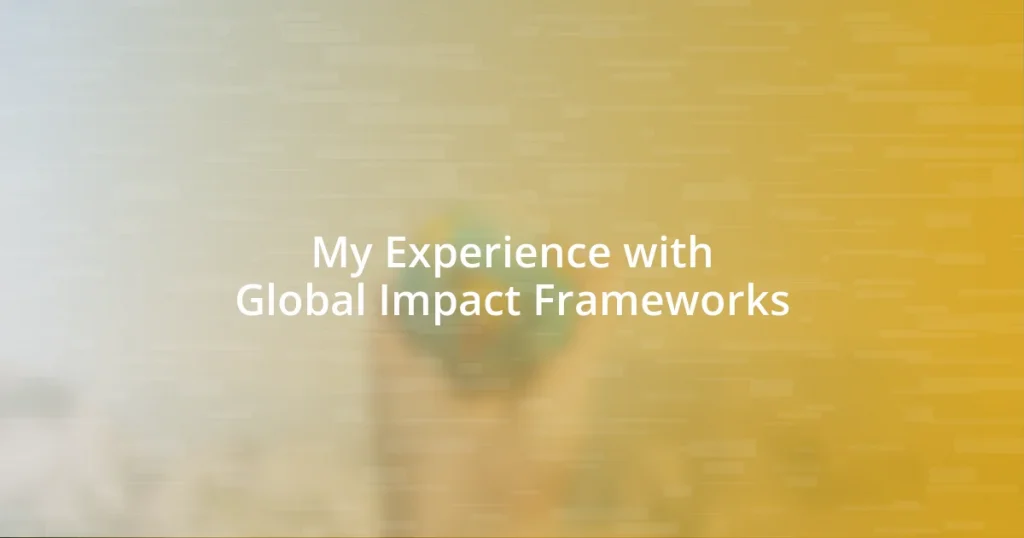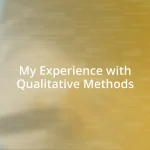Key takeaways:
- The importance of clear objectives and stakeholder engagement in achieving meaningful impact.
- Combining qualitative insights with quantitative data enriches understanding and enhances project outcomes.
- Listening to community concerns and being adaptable are essential for fostering trust and driving successful collaborations.

Understanding Global Impact Frameworks
Global impact frameworks serve as essential blueprints for organizations aiming to create meaningful change. I recall my first exposure to one of these frameworks during a workshop; the terms and metrics seemed daunting at first, yet I quickly learned how they provided clarity and direction. Isn’t it fascinating how a structured approach can transform a lofty vision into actionable steps?
At their core, these frameworks help quantify social, economic, and environmental impacts. I remember grappling with the concept of the triple bottom line—people, planet, and profit—when trying to evaluate a project. This was a pivotal moment for me: realizing that success isn’t just about financial gains, but also about fostering community well-being and environmental stewardship. How often do we overlook the broader consequences of our actions?
Engaging with these frameworks can feel like peeling back layers of an onion; each layer reveals more complexity and opportunity. I found it rewarding to assess my own contributions through these lenses, prompting me to ask tough questions: Are my efforts genuinely making a difference? This ongoing self-reflection enhances not only my projects but also my professional growth, ensuring that I remain aligned with the values of sustainability and social responsibility.

Key Components of Impact Frameworks
When I think about the key components of impact frameworks, one that always stands out is the importance of clear objectives. In one of my projects, I remember sitting down with my team to outline our goals. This experience was eye-opening; we realized that without specific targets, our efforts felt unfocused. It’s like trying to hit a moving target without knowing where it is. Having well-defined objectives not only aligned our vision but also made it easier to measure our success.
Another critical component is stakeholder engagement. I recall participating in a community consultation process where local voices were incorporated into the decision-making. This deeply resonated with me; it became clear that involving those who are directly affected by the initiatives can enhance their relevance and impact. When stakeholders feel valued and heard, it lays a foundation for trust and collaboration that can transform projects into long-lasting solutions.
Lastly, data collection and impact measurement are indispensable in these frameworks. I was once tasked with gathering feedback on an environmental initiative. To my surprise, many participants had insightful thoughts that went beyond mere numbers. It highlighted how qualitative data, along with quantitative metrics, creates a fuller picture of impact. This dual approach allows for adaptations and improvements along the way, making the framework not just a static guide, but a dynamic tool for evolution.
| Component | Description |
|---|---|
| Clear Objectives | Defining specific, measurable goals to guide initiatives. |
| Stakeholder Engagement | Involving affected communities to enhance relevance and trust. |
| Data Collection & Measurement | Utilizing both qualitative and quantitative data for a comprehensive understanding. |

My Journey with Global Impact
I remember the very moment I decided to explore global impact frameworks more seriously. It was during my time working on a project aimed at improving education access in underserved communities. Engaging with local stakeholders not only humbled me but also inspired me profoundly. Their stories shaped my understanding of impact; I learned that real change starts by listening and forging relationships. Those interactions solidified my belief that addressing global issues requires a communal effort, one that values every voice along the way.
- Attending workshops was a game-changer for me, providing the language to articulate my vision.
- Overcoming initial confusion with metrics opened a door to better project planning.
- Collaborating with diverse teams highlighted the unique perspectives that fuel creativity and innovation.
Reflecting on those experiences, I can see how they paved the way for my commitment to social responsibility. Each new project felt like an opportunity to dig deeper and challenge the status quo, unveiling layers of knowledge and perspective I never anticipated. I often ask myself, “How can I turn these insights into action?” It became a motivating force, guiding my professional journey and fueling my passion for making a lasting difference.

Practical Applications of Impact Frameworks
Impact frameworks offer a multitude of practical applications that I have witnessed firsthand. For instance, during a sustainable agriculture project, we implemented a framework to assess local farmers’ needs. The clarity it provided helped us to direct resources effectively, ensuring the initiative genuinely empowered the community rather than imposing solutions.
In another scenario, I found myself working with a nonprofit focused on urban renewal. We utilized our impact framework to set benchmarks, like improving community engagement rates and reducing waste. By discussing these metrics regularly with team members, we created a culture of accountability and learning. Doesn’t it feel rewarding when you can see the tangible results of your efforts laid out so clearly?
I’ve also seen how these frameworks can guide funding decisions. When collaborating with a grant-making organization, I remember presenting our impact data, which decisively influenced their support. The ability to demonstrate potential outcomes and impact gave us leverage that opened doors for further investment. This experience solidified my understanding that data-driven storytelling can be a powerful tool for achieving goals.

Challenges in Implementing Frameworks
Implementing global impact frameworks isn’t without its hurdles. I recall one project where we faced significant resistance from local leaders who were skeptical about the framework’s benefits. Their hesitation made me realize that change often requires patience and relationship-building. Why do people resist new ideas? Often, it boils down to fear of the unknown, and if we want to overcome that, we must engage them in open dialogue.
Another challenge I encountered was navigating the complex metrics inherent in many frameworks. I remember feeling overwhelmed during discussions of impact indicators that seemed to have little relevance to our field. It’s easy to become bogged down in data and lose sight of the human stories behind the numbers. How do we strike a balance between quantitative data and qualitative experiences? I learned that blending both perspectives not only enriches understanding but also drives more meaningful outcomes in our projects.
One of the most significant barriers I faced was the resource allocation struggle. It often felt like we were juggling priorities, and I had to confront the reality that not every initiative could get the attention it deserved. When resources are limited, tough decisions must be made. I vividly remember grappling with whether to expand our outreach or invest in deeper community partnerships. That moment taught me the importance of strategic planning and reassessing priorities to align with the true essence of our mission. Have you ever faced a similar dilemma? It’s a delicate dance—and one that can define the success of our initiatives.

Measuring Success with Impact Frameworks
Measuring success with impact frameworks can be quite a journey. I remember a particular instance during a youth mentorship program where we decided to evaluate our success through feedback surveys. The responses were incredibly revealing; while we learned that our sessions helped boost participants’ confidence, the metrics also unearthed areas for improvement, like the need for better follow-up resources. Isn’t it amazing how raw data can spark such deep introspection and drive change?
One even more profound experience for me was during a health initiative where we aimed to reduce chronic disease rates in a community. As we tracked health outcomes, I felt a strong connection to the people we were serving. Each percentage point we improved wasn’t just a number; it represented real lives transformed, families inspired, and futures altered. At that moment, I realized that these frameworks aren’t just about numbers; they’re about narratives and human experiences. Don’t you feel that metrics can only tell part of the story?
Additionally, I faced a pivotal moment during a project evaluation meeting that stands out. We presented detailed analytics, but when I shared a heartfelt story from a participant—how our program helped her overcome barriers to education—the room fell silent. It was clear that while data is important, it’s the human impact that resonates on a deeper level. Reflecting on that moment made me appreciate the delicate balance we need to achieve between hard data and the emotional connections we foster through our work. How do we ensure that we highlight both in our discussions? It’s a challenge worth embracing.

Lessons Learned for Future Use
There’s a lot to learn from the challenges we face in implementing global impact frameworks. One of my most impactful lessons came from a project that floundered due to unaddressed community concerns. I remember leading a workshop where participants shared their fears about change. That experience taught me that listening is just as crucial as presenting solutions. If we want to foster genuine collaborations, we must prioritize understanding and addressing the emotional landscape of our stakeholders. Isn’t it fascinating how fostering trust can be the bedrock for tangible progress?
Another insight I gained revolves around the importance of flexibility in the face of evolving circumstances. In one initiative, we set out with a rigid plan, only to discover halfway through that our initial assumptions were off base. It felt like a hurdle, but I realized we could adjust our strategies to better serve our community’s needs. This taught me that a successful framework isn’t set in stone; it’s a living entity that should adapt as we gather more information. Have you ever had to pivot in response to unexpected challenges? Embracing change is often what leads to the most significant breakthroughs.
Lastly, I learned that collaboration across diverse sectors enriches the process. During a joint project with local businesses, I witnessed firsthand how different perspectives brought innovative solutions to the table. The synergy we created proved that tapping into various expertise not only enhances problem-solving but also fortifies commitment to the collective mission. It made me wonder—how often do we challenge ourselves to incorporate outside voices into our frameworks? Those moments of collaboration can truly ignite creativity and drive impactful change.















